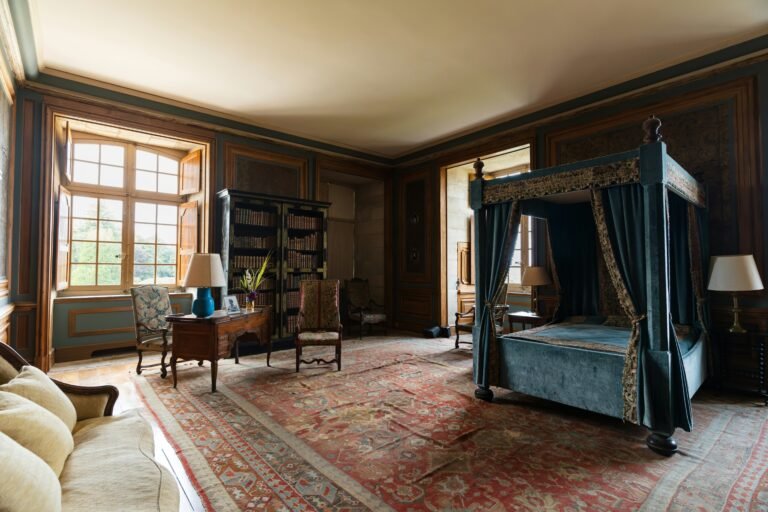Interior design styles are more than just decorating trends. They shape the way we live, influence our moods, and create the atmosphere that makes a house feel like home. When I first started exploring different interior design styles, I remember feeling overwhelmed by the variety – modern, rustic, Scandinavian, bohemian, and so many more. But once I learned how each style carried its own story, philosophy, and aesthetic, designing my spaces became not just easier, but more enjoyable.
Every style has a personality. Some emphasize simplicity and functionality, while others highlight bold expression or timeless elegance. Choosing the right one for your home is not about following rules, it’s about finding a design language that resonates with you. The way we decorate our spaces reflects our individuality, lifestyle, and even our cultural influences.
In this ultimate guide, we’ll explore the most influential and inspiring interior design styles from sleek modern interiors to cozy rustic retreats, from airy Scandinavian minimalism to the colorful freedom of bohemian living. Along the way, I’ll share practical insights on how to identify, adapt, and combine these styles so that your home doesn’t just look beautiful, but also feels authentic to you.
What Are Interior Design Styles and Why Do They Matter
At its core, an interior design style is a framework that guides how a space looks and feels. It goes beyond furniture or paint colors. A style represents a philosophy of living, balancing aesthetics with function. For example, modern interior design focuses on clean lines and open layouts, while rustic interior design celebrates raw textures and natural warmth.
Interior design styles matter because they directly impact comfort and emotional well-being. Research shows that the design of our surroundings can influence productivity, relaxation, and even creativity. When your home aligns with your personality, it becomes a sanctuary where you feel truly at ease.
Styles also carry cultural stories. Scandinavian interiors highlight simplicity and functionality, reflecting a lifestyle centered on hygge, or cozy living. Meanwhile, bohemian interiors are rooted in free-spirited creativity, mixing patterns, colors, and global influences. Understanding these nuances helps you choose not just what looks good but what feels right for your daily life.
I’ve noticed that once people understand styles, they feel empowered. Instead of randomly buying furniture or decor, they create a cohesive vision. This doesn’t mean you must stick rigidly to one style—many of the most inspiring homes artfully blend different influences. But starting with a clear understanding of styles is the foundation for balance and harmony.
For more insights on why design matters in everyday living, you can explore resources like Architectural Digest and Dezeen, both of which showcase evolving global design trends.
Modern Interior Design Styles
Modern design has become one of the most widely recognized approaches in today’s homes. It’s not only about sleek appearances but also about creating functional, uncluttered, and comfortable living spaces. Over the years, modern interiors have branched into several distinct sub-styles, each with its own character.
Modern Interior Design
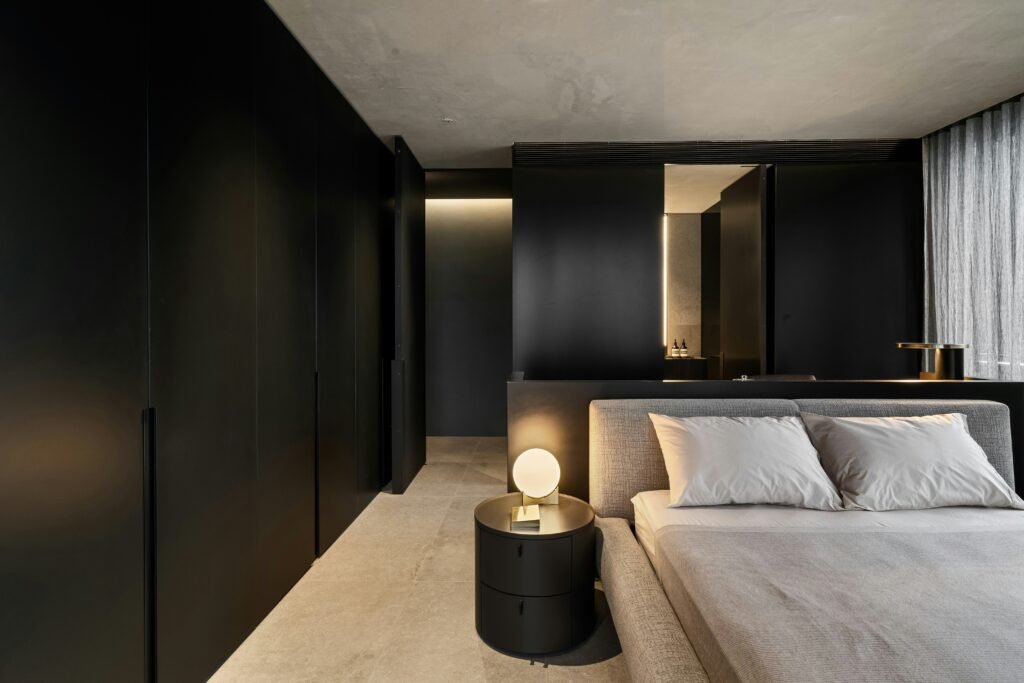
At its heart, modern interior design emphasizes simplicity, clean lines, and open spaces. This style emerged in the early to mid-20th century and was heavily influenced by the Bauhaus movement, which combined art with practical craftsmanship. Think neutral color palettes, uncluttered rooms, and carefully selected statement pieces.
I’ve always found modern interiors refreshing because they give breathing room to the mind. When I worked from home in a modern-styled space, the absence of clutter helped me stay focused and calm. If you value efficiency and minimal fuss, modern interiors may be the ideal choice.
For inspiration, take a look at Houzz’s modern interior design section, which offers real-world examples from homeowners and designers.
Mid-Century Modern
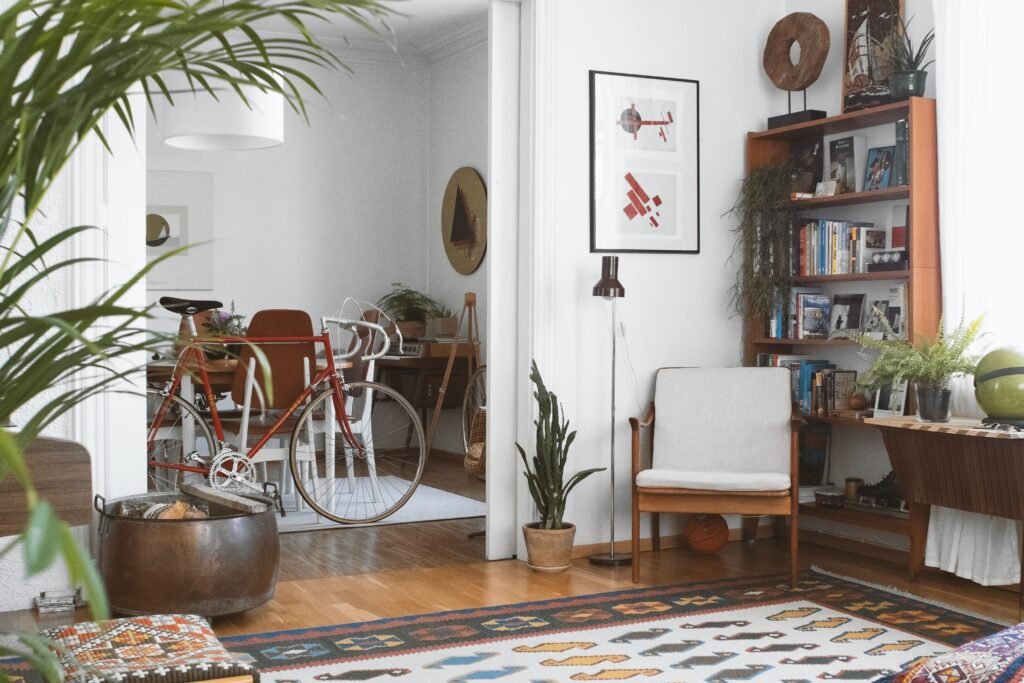
The mid-century modern style is one of the most iconic design movements of the 20th century. Defined by its organic shapes, bold use of materials like teak and walnut, and a mix of natural and manufactured elements, this style continues to dominate furniture showrooms today.
Signature pieces such as the Eames lounge chair or Noguchi coffee table remain symbols of timeless design. I love mid-century modern because it blends nostalgia with practicality. It feels warm and stylish without being over the top.
For more history on this style, Dwell often highlights mid-century homes and offers fantastic design ideas.
Industrial Style Interiors
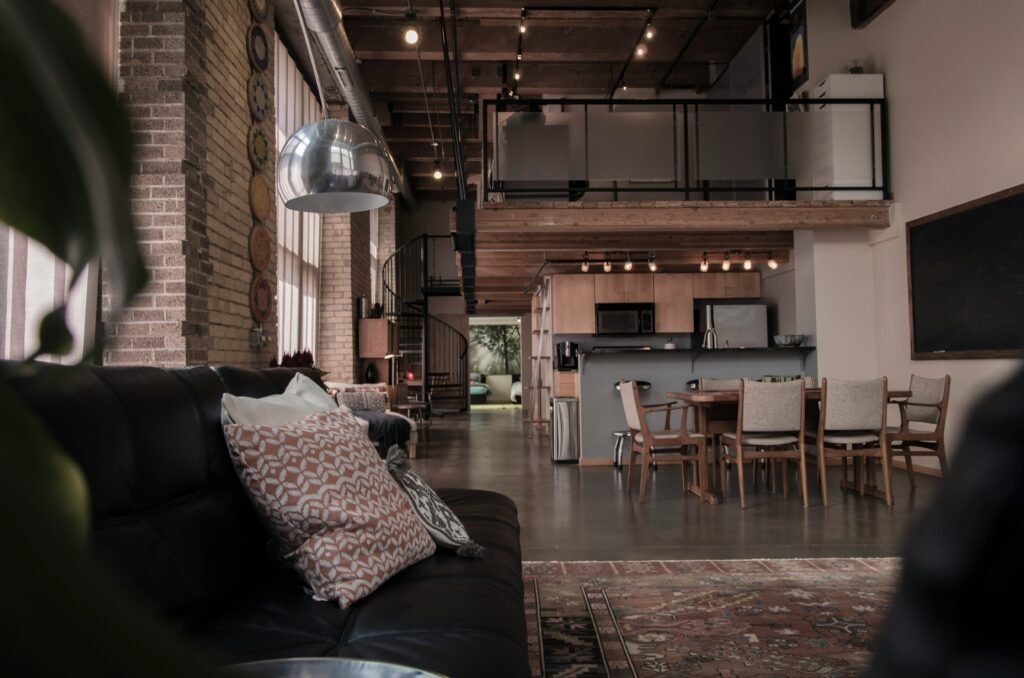
Born from the conversion of warehouses and factories into living spaces, industrial style interiors celebrate exposed brick, steel beams, and raw wood. It’s about highlighting the building’s structure instead of hiding it. Open layouts, oversized windows, and utilitarian lighting are all trademarks.
If you live in a city apartment or loft, industrial interiors can add character and uniqueness. I once stayed in an industrial-style Airbnb in Brooklyn, and I still remember the striking mix of metal fixtures and cozy rugs, it felt edgy yet livable.
For ideas on industrial layouts and decor, check out The Spruce’s industrial design guide.
Urban Modern Interiors
Urban modern interiors are like industrial’s polished cousin. This style blends modern minimalism with soft, luxurious touches like plush sofas, chic art pieces, and elegant finishes. It’s perfect for city living where space is limited but style is a priority.
Urban modern design thrives on balance: it’s sleek yet warm, contemporary yet personal. The key is layering textures like glass, wood, textiles to avoid sterility. Whenever I’ve visited homes styled this way, I’ve noticed how inviting they feel despite their streamlined look.
Rustic and Nature Inspired Styles
Not everyone is drawn to sleek lines and minimalist layouts. For those who love warmth, comfort, and a connection to the outdoors, rustic interior design styles and their nature-inspired variations are the perfect fit. These styles celebrate natural beauty, raw materials, and timeless coziness.
Rustic Interior Design
Rustic interior design is rooted in simplicity and natural elements. Think exposed wooden beams, stone fireplaces, and handcrafted furniture. It’s about embracing imperfections—scratched wood, uneven textures, and organic shapes—that make a home feel authentic and lived-in.
When I renovated a cabin-style space years ago, I realized how grounding rustic interiors can be. There’s something soothing about wood grain and earthy colors that no modern surface can replace. If you want to create a retreat-like atmosphere, rustic interiors are a wonderful choice.
For design inspiration, Country Living offers countless rustic decor ideas that blend tradition with comfort.
Cottagecore Interiors
The cottagecore trend is a romantic interpretation of rustic living. Inspired by rural cottages, it combines floral prints, cozy quilts, and a sense of simplicity. Cottagecore interiors celebrate nostalgia, slowing down, and reconnecting with nature indoors.
I’ve always admired this style for its charm, it feels like stepping into a storybook. Soft pastel palettes, vintage decor, and natural fibers like linen are typical. It’s particularly popular among those who want their home to feel whimsical yet comforting.
Modern Farmhouse
Farmhouse interiors balance rustic charm with modern convenience. The traditional farmhouse style leans heavily on antiques, distressed finishes, and muted colors. In contrast, the modern farmhouse integrates cleaner lines, updated lighting, and open layouts while still keeping rustic materials like wood and metal.
When I combined elements of modern farmhouse into my kitchen, I found it was the perfect middle ground: functional and contemporary, but still warm. The farmhouse sink and reclaimed wood shelves became both practical and stylish focal points.
For deeper guidance, HGTV’s farmhouse design tips provide practical ways to adopt this style.
Coastal Style Interiors

Coastal interiors capture the breezy, relaxed vibe of seaside living. Soft blues, sandy neutrals, and airy fabrics dominate these spaces. Natural light plays a huge role, and decor often includes driftwood, seashells, and nautical accents.
Even if you don’t live by the sea, coastal interiors can make your home feel like a calming getaway. I once decorated a small apartment with white curtains, rattan furniture, and ocean-themed accents, and it instantly felt brighter and more uplifting.
If you’re drawn to this style, House Beautiful’s coastal design ideas are a great resource.
Biophilic Design and Sustainable Interiors
The growing movement toward eco-conscious living has given rise to biophilic design and sustainable interiors. These approaches bring the outdoors in like incorporating plants, natural light, organic materials, and environmentally friendly solutions.
Biophilic design isn’t just about aesthetics, it’s about wellness. Studies show that integrating natural elements indoors can reduce stress and improve focus. I’ve personally noticed the difference after adding more greenery to my workspace, it feels alive and energizing.
For sustainability tips, the U.S. Green Building Council offers valuable insights on eco-friendly design practices.
Scandinavian and Minimalist Styles
Scandinavian and minimalist interiors share a love for simplicity, function, and calm spaces. Yet each carries its own cultural meaning and design language. These styles have become global favorites because they make homes feel uncluttered, cozy, and refreshing all at once.
Scandinavian Interior Design
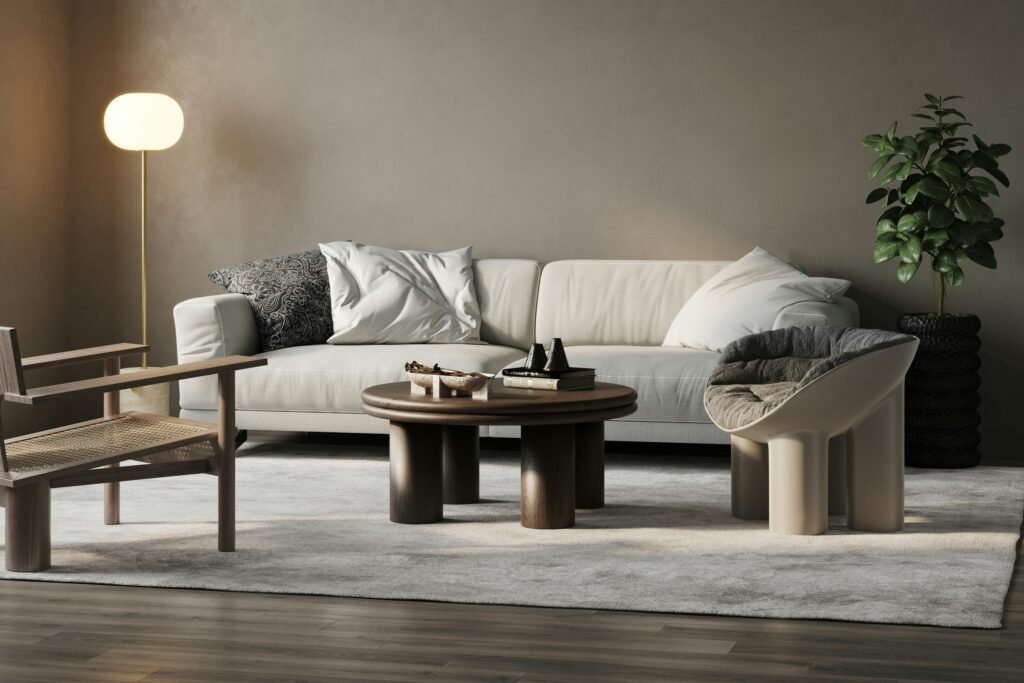
Scandinavian interior design is characterized by light colors, clean lines, and a sense of balance. The focus is on function without sacrificing beauty. Pale wood floors, simple furniture, and neutral tones dominate, while cozy textiles like wool throws and sheepskin add warmth.
What makes Scandinavian design unique is its focus on hygge, a Danish and Norwegian concept of coziness and well-being. I adopted some Scandinavian principles in my own living room by layering soft textures with neutral furniture, and it instantly created a space where I could unwind after long days.
For inspiration, Scandinavia Standard is an excellent resource on this timeless design approach.
Japandi Style
Japandi is a fusion of Japanese and Scandinavian design, blending minimalism with warmth. Japanese interiors emphasize natural materials, craftsmanship, and mindfulness, while Scandinavian design brings in lightness and comfort. Together, they create spaces that feel both serene and functional.
This style appeals to me personally because it balances restraint with comfort. A Japandi dining room, for example, might feature a low wooden table, soft neutral tones, and carefully placed greenery. Nothing excessive, yet everything intentional.
Minimalist Interior Design

Minimalist interior design is the art of less. It prioritizes open spaces, neutral colors, and essentials only. The idea isn’t to live in an empty room but to create clarity by reducing visual clutter.
Living minimally taught me a powerful lesson: fewer things can mean more peace. I once pared down my bedroom to a bed, two side tables, and a single piece of wall art. The result was a calmer, distraction-free environment that improved my sleep.
If you’re curious about how minimalism influences well-being, The Minimalists provide thought-provoking insights that extend beyond interiors.
Japanese Zen Interiors
While Japandi borrows from Japan, Japanese Zen interiors stand on their own as a deep tradition. Rooted in Zen philosophy, they embrace tatami mats, sliding shoji screens, and a harmonious connection with nature. The design is meditative—spaces are uncluttered and deeply intentional.
I admire Zen interiors for how they slow you down. Spending time in a space designed this way feels almost like entering a sanctuary. Soft lighting, natural wood, and a few carefully chosen pieces are enough to create balance.
For authentic examples, Japan House often highlights Japanese cultural design elements worth exploring.
Eclectic and Bold Styles
Not all interiors are calm or subdued. Some are designed to surprise, energize, and showcase personality. Eclectic and bold interior design styles embrace experimentation, layering, and sometimes even breaking the rules. These spaces thrive on creativity, making them truly unique.
Bohemian Interior Design

Bohemian interior design is free-spirited, colorful, and full of life. It combines patterns, textures, and global influences to create spaces that feel relaxed and expressive. Think vibrant rugs, layered pillows, rattan furniture, and plants scattered everywhere.
I’ve always found bohemian interiors liberating. A friend’s boho-style living room once struck me as the perfect balance of comfort and character. It had Moroccan rugs, vintage lamps, and plenty of cozy corners. There was no rigid formula, yet everything felt harmonious.
For ideas, Elle Decor’s bohemian design guide offers stunning inspiration.
Maximalist Design
If minimalism is about restraint, maximalist design is its polar opposite. This style celebrates “more” – more patterns, more colors, more layers. Maximalist interiors often mix bold wallpaper, eclectic art collections, and statement furniture in vibrant combinations.
What I admire about maximalism is its courage. I once visited a home where every wall carried a different story: tropical prints in the dining room, abstract art in the hallway, and jewel-toned furniture in the living room. Surprisingly, it worked beautifully because the owner embraced it fully.
Eclectic Interiors
Eclectic style is about mixing and matching—blending vintage with modern, rustic with glam, or Eastern with Western influences. Unlike maximalism, which thrives on abundance, eclecticism is more about harmony within contrast.
The key to pulling off eclectic design is balance. You can combine very different pieces, but they should share something in common like color palette, shape, or mood. I’ve used eclectic touches myself by mixing mid-century modern chairs with a rustic farmhouse table, and the contrast felt stylish rather than chaotic.
Dark Academia Decor

For those who love moody, intellectual environments, dark academia decor has gained popularity. This style borrows from historic libraries and old-world universities. Rich wood, dark tones, antique books, and gothic details.
I’m drawn to this style whenever autumn arrives it makes spaces feel cozy, dramatic, and steeped in character. Adding a dark leather chair and shelves of vintage books can instantly set the mood.
For inspiration, Veranda’s dark academia feature showcases practical ways to achieve this look.
Gothic Revival Interiors
Gothic revival interiors take drama a step further with pointed arches, ornate carvings, and bold dark palettes. This style originated in the 19th century but still influences homes today, especially those looking for historical richness.
Visiting a Gothic revival home once left me in awe—the stained-glass windows and intricate woodwork were works of art. While this style may not suit every space, it adds grandeur and timeless depth where it fits.
Classic and Historical Styles
Classic and historical interiors carry a sense of elegance, refinement, and timeless beauty. They draw from the past but continue to inspire today’s homes. These styles are rich in detail and often appeal to those who love tradition and storytelling through design.
Victorian Interiors
Victorian interior design is known for its ornate details, dramatic drapery, patterned wallpaper, and elaborate furniture. Originating during Queen Victoria’s reign, this style emphasized opulence and social status.
When I toured a restored Victorian home, I was struck by the craftsmanship. Carved wood, stained glass, and intricate ceiling medallions. While it may feel heavy compared to modern styles, Victorian interiors exude warmth and grandeur when done thoughtfully.
For more depth, Victoria Magazine often explores Victorian-inspired living and design.
Art Deco Interiors
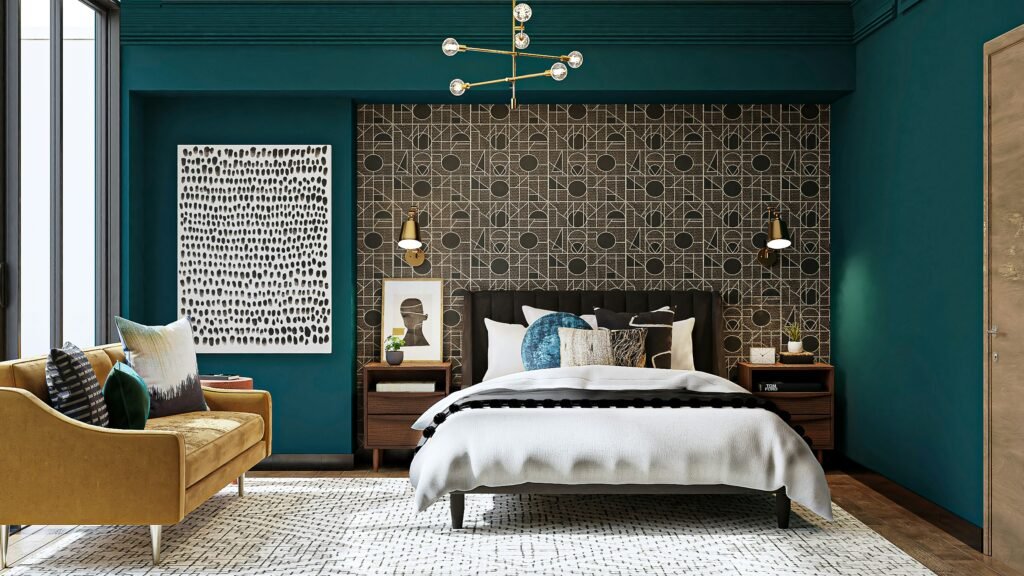
The glamour of the 1920s and 1930s lives on in Art Deco interiors. Defined by geometric shapes, metallic finishes, and bold contrasts, this style oozes luxury and sophistication. Black and gold combinations, mirrored surfaces, and statement lighting are all classic Art Deco elements.
I’ve always admired Art Deco for its bold confidence, it makes every room feel like a stage. The first time I stepped into an Art Deco–styled hotel lobby, the grandeur of its symmetry and gold accents felt unforgettable.
For inspiration, The Art Deco Society of New York shares valuable resources on this glamorous style.
Hollywood Regency
If Art Deco is about structured luxury, Hollywood Regency is about playful glamour. Popular in the 1930s through 1950s, it embraces bold colors, lacquered finishes, and dramatic furniture. Think mirrored vanities, lush fabrics, and statement chandeliers.
Hollywood Regency is a favorite of mine for small spaces, it makes even modest rooms feel extravagant. Adding a single bold accent, like a velvet chair or a mirrored coffee table, instantly elevates the mood.
Retro Revival and Steampunk Inspired
Some historical styles take a quirky turn. Retro revival draws from the 1960s and 70s, bringing back groovy colors, shag rugs, and funky furniture. Meanwhile, steampunk interiors blend Victorian elegance with industrial fantasy – gears, brass fixtures, and vintage curiosities.
I once visited a café designed in steampunk style, and it felt like stepping into an alternate universe. It was imaginative and immersive, showing how interiors can be more than decor, they can be experiences.
If retro charm is more your vibe, Apartment Therapy’s retro guide offers plenty of playful ideas.
Mediterranean and Global Influences
Mediterranean and globally inspired interiors celebrate color, culture, and a lifestyle of relaxation. They bring sunshine, history, and wanderlust into the home, making spaces feel vibrant and deeply personal.
French Country Aesthetic
French country interiors balance rustic charm with refined elegance. Typical features include distressed wood furniture, soft floral fabrics, and muted tones like lavender, cream, and pale blue.
I once stayed in a countryside inn in Provence that perfectly captured this style. Stone walls, linen curtains, and wrought-iron chandeliers created an atmosphere that was both sophisticated and cozy. French country is ideal if you want a home that feels warm but not overly formal.
For inspiration, The Spruce’s French country design guide is an excellent resource.
Mediterranean Interiors
Mediterranean interiors draw from Italy, Greece, and Spain, featuring sun-drenched colors, terracotta tiles, and arched doorways. They are designed to feel breezy and welcoming.
A modern take on this is Amalficore, a trend inspired by the Amalfi Coast. It blends Mediterranean blue-and-white palettes with natural textures and relaxed outdoor-indoor living. I’ve always loved how this style makes even a city apartment feel like a seaside retreat.
Even balconies can be transformed with Mediterranean flair. Add a bistro table, vibrant tiles, and cascading plants. For practical examples, Better Homes & Gardens has beautiful Mediterranean design features.
Moroccan Interiors
Moroccan design is bold, colorful, and rich in patterns. Mosaic tiles, lanterns, and jewel-toned textiles create interiors that are both exotic and inviting. Low seating arrangements and layered rugs often complete the look.
I find Moroccan interiors particularly inspiring because they engage all the senses. Warm colors, textured fabrics, and even the soft glow of lantern light create a truly immersive space.
For authentic references, Moroccan Interiors on Architectural Digest showcase how this vibrant style continues to influence modern homes.
Global Fusion Styles
Many homes today embrace global fusion, blending elements from different cultures. A Moroccan rug might sit under a Scandinavian sofa, or a Japanese lamp might complement a French farmhouse table.
The beauty of global fusion is its flexibility. I personally enjoy incorporating small global accents like souvenirs from travel, artisanal crafts, or textiles from abroad into otherwise simple spaces. It makes a home feel unique and tells a personal story.
Transitional and Timeless Choices
Some homeowners don’t want to commit fully to traditional or modern styles. That’s where transitional and timeless interiors come in. They bridge the gap, offering flexibility and balance while still feeling cohesive.
Transitional Style
Transitional interiors combine the best of traditional warmth with contemporary simplicity. Neutral color palettes, clean-lined furniture with classic details, and balanced proportions define this approach.
I’ve used transitional design in my own dining room, pairing a traditional wooden table with modern upholstered chairs. The result felt welcoming yet fresh, which is exactly what transitional style does best.
For deeper insights, Houzz’s transitional design ideas provide endless real-life examples.
Modern Traditional Trend
The modern traditional style is slightly more structured than transitional. It leans on symmetry, statement furniture, and elegant finishes, but avoids becoming stuffy. This trend has grown because it brings comfort without sacrificing sophistication.
I admire modern traditional interiors because they work well in both old and new homes. For instance, a sleek sofa paired with ornate crown molding looks just as natural in a city loft as in a suburban house.
Timeless vs Trendy
One of the biggest challenges in interior design is balancing timelessness with trends. Timeless elements include neutral walls, quality wood furniture, and classic lighting fixtures—pieces that don’t lose appeal after a few years. Trends, on the other hand, keep spaces fresh and exciting.
I believe the secret lies in using timeless foundations while layering in trendy accents. In my own home, I’ve kept the core pieces neutral and long-lasting, while playing with trendy colors through cushions, art, and rugs. That way, when trends shift, I can easily update without starting from scratch.
How to Choose the Right Interior Design Style for Your Home
With so many beautiful styles to explore – modern, rustic, Scandinavian, bohemian, and beyond it can feel overwhelming to decide which one is right for your home. The good news is that you don’t have to pick just one. Instead, you can use a few guiding principles to find the direction that best fits your personality and lifestyle.
1. Consider Your Lifestyle
Your daily routine should influence your design choices. Do you host gatherings often? A welcoming rustic or farmhouse style might be ideal. Prefer quiet reflection? Minimalist or Japanese Zen interiors could suit you better.
When I first experimented with design, I realized I needed a space that supported my work-from-home lifestyle. That’s why I leaned toward Scandinavian simplicity, it helped me focus while still feeling cozy.
2. Look at Your Architecture
The bones of your home can guide you toward a natural fit. High ceilings and large windows often work well with modern or industrial styles. Older homes with intricate details may shine with traditional or Victorian touches.
I’ve found that respecting the architecture makes decorating much easier. In one apartment I lived in with exposed brick, an industrial approach felt effortless because the foundation was already there.
3. Pay Attention to Your Emotions
Ask yourself: how do you want to feel in each room? Calm and serene? Go minimalist or Japandi. Energized and creative? Bohemian or maximalist might be better. Grounded and cozy? Rustic or cottagecore could be perfect.
4. Mix Styles Thoughtfully
Blending styles can create the most interesting spaces, but it must be intentional. Choose one dominant style, then add secondary influences through accents. For example, you might have a modern living room base with bohemian textiles for warmth and personality.
In my own home, I’ve combined Scandinavian furniture with rustic decor accents. The balance makes my spaces both functional and inviting without clashing.
5. Start Small
If you’re unsure, begin with a single room. Experiment with colors, textures, and furniture, then expand your style choices throughout the rest of your home. This way, you can refine your preferences without feeling locked in.
For additional guidance, Houzz’s design style quiz is a fun tool to help identify your natural leanings.
Conclusion
Exploring different interior design styles is more than a decorating exercise, it’s about discovering how you want to live. From the sleek sophistication of modern interiors to the warmth of rustic spaces, the calm of Scandinavian simplicity to the vibrance of bohemian creativity, each style offers a unique way to shape your home and reflect your personality.
What I’ve learned from my own journey is that there’s no single “right” choice. A home should feel authentic, comfortable, and supportive of your lifestyle. You might embrace one style fully, or you may find joy in blending elements – rustic wood with modern lighting, or Scandinavian minimalism with a touch of bohemian flair. The beauty lies in creating a space that feels truly yours.
As trends come and go, the most important factor is how your home makes you feel every day. Use timeless foundations, add personality through accents, and don’t be afraid to experiment. Design is personal, flexible, and endlessly inspiring.
So whether you’re starting fresh, renovating, or just adding a few new touches, let your chosen interior design style guide you toward a home that not only looks beautiful but also feels like your perfect sanctuary.
Alex is the creator of Homely Haven, a space dedicated to simple, stylish ideas for interiors and gardens alike. With a passion for cozy living rooms, inviting outdoor spaces, and practical DIY solutions, Alex shares tips and guides that help turn any house into a true home.
From budget-friendly decorating hacks to weekend garden projects, the goal is always the same: to inspire you to create spaces that feel personal, beautiful, and welcoming. When not writing, Alex is usually rearranging furniture, sketching new garden layouts, or exploring design trends for the next project.




